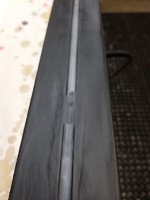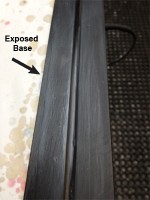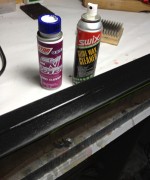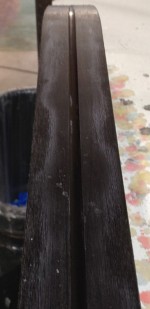For many skiers, the ski season has come and gone. Now is the time to take a quick check of your skis before you put them away for the season. Gear West recommends a treatment of fluoro cleaner or a hot scrape after each race (when fluoros are used) and again at the end of the season. The reason behind this is fluorinated wax will clog the surface of a ski base. If the fluoro is left on, the base won’t readily accept wax, dry out and become slower. Repeated use of fluoros or excessive heat can damage the ski base to the point that fluoro cleaner or a hot scrape will not fix the problem. In this case, the ski base is essentially scabbed and a stone grind is necessary to open up fresh P-Tex.
There are two methods for removing/cleaning fluoros from a ski base:
Hot scrape: This is a long time standby method, however, care must be exercised so the base is not harmed. I have seen many damaged bases from improper hot scraping.
• Apply a soft ski wax such as Swix CH10, CH8, or BP99 with an iron temperate that does not cause the wax to smoke.
• As soon as you are done applying the wax, carefully scrape the wax off the base. This will pull off the fluoros and any remaining dirt from the base.
• Let the base cool down and then brush out the remaining wax with a fine steel or nylon brush. • Apply storage wax or the wax of the day.
Fluoro cleaner: This is my preferred method because there is no risk of overheating or destabilizing the base. • Brush the base with a detuned fine steel brush to clear away any extra wax or dirt. (3 – 5 strokes) • Liberally apply fluoro cleaner and scrub it into the base with a nylon brush. • Apply more fluoro cleaner to the base and spread evenly with fiberlene.
• Let the fluoro cleaner dry thoroughly; 10-60min. World Cup wax technicians report that one should error on the longer side to allow the cleaner to work more effectively.
• Brush away the residue with a horse hair brush. • Apply storage wax or the wax of the day.
Now comes the easy part. After skis are clean and clear of fluoro apply a thick layer of wax to protect the ski base from oxidation. Make sure to double check that the wax has flowed evenly under the iron and no parts of the base are exposed. Apply more wax if you find thin spots. Thin spots can become a problem if the base is oxidized and absorbs the thin layer of wax over the summer, by August parts of the ski base will become exposed. That being said, make certain to get a nice even thick layer of wax covering the entire base. I like to use Swix BP88 or BP99 to store my warm race skis and I store my cold race skis with Swix BP77. I like to store my training skis with LF6 so when it snows the following year, I can quickly scrape the ski and and have it ready to use!
Why Hotbox:
There is much confusion on when to hotbox a ski. The only reason to hotbox a ski is to saturate the base. If the ski has already been waxed a lot and well taken care of, no hotbox treatment is needed. A problem with hotbox treatment is overuse, over temperature, under waxed or improper wax. Every time a ski is hotboxed, the potential exists to alter the flex pattern of the ski or damage the base. Make sure to use a reputable shop that is knowledgeable of the temperature, duration and wax type for proper hot box treatment. I usually only have my skis hotboxed when they are new or newly stoneground. As a rule of thumb, if you are an active racer, a stonegrind is need on a yearly basis for your most utilized race skis. Specialty race skis that don’t see much action can go 2-3 years between re-grinding.
Flex Testing for Performance:
And don’t forget to check you your skis with the Gear West Flex Tester. If you are unsure about the status of your ski or ski quiver, we are here to help you. Let us determine if your skis fit, what conditions they are best suited, if they match, and just whether they are a “fast” pair.








